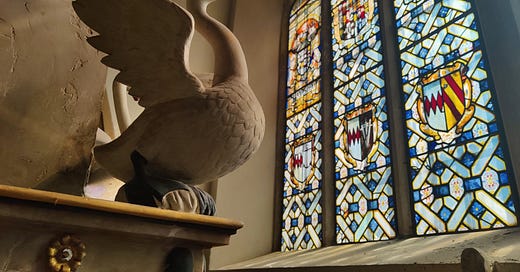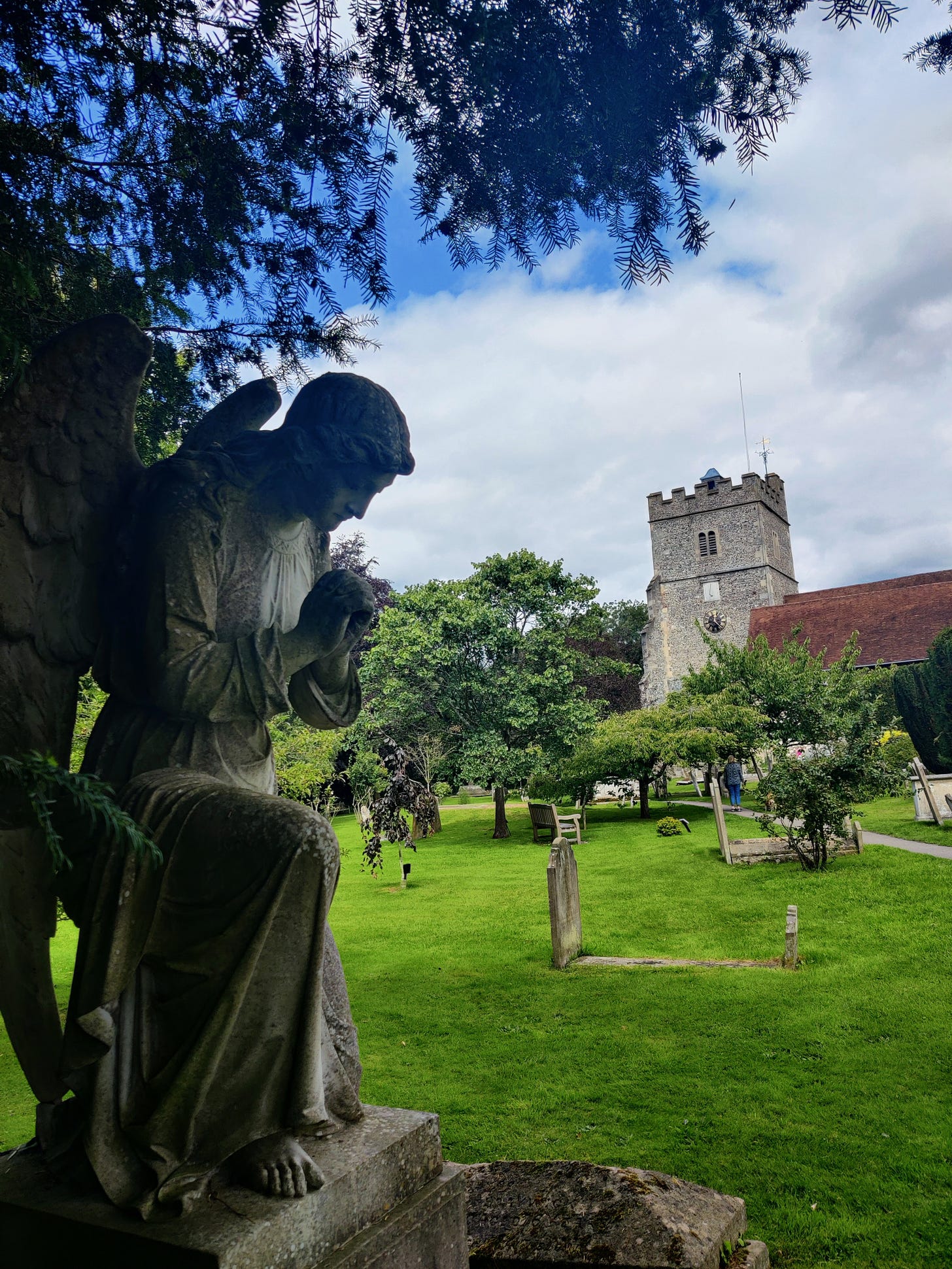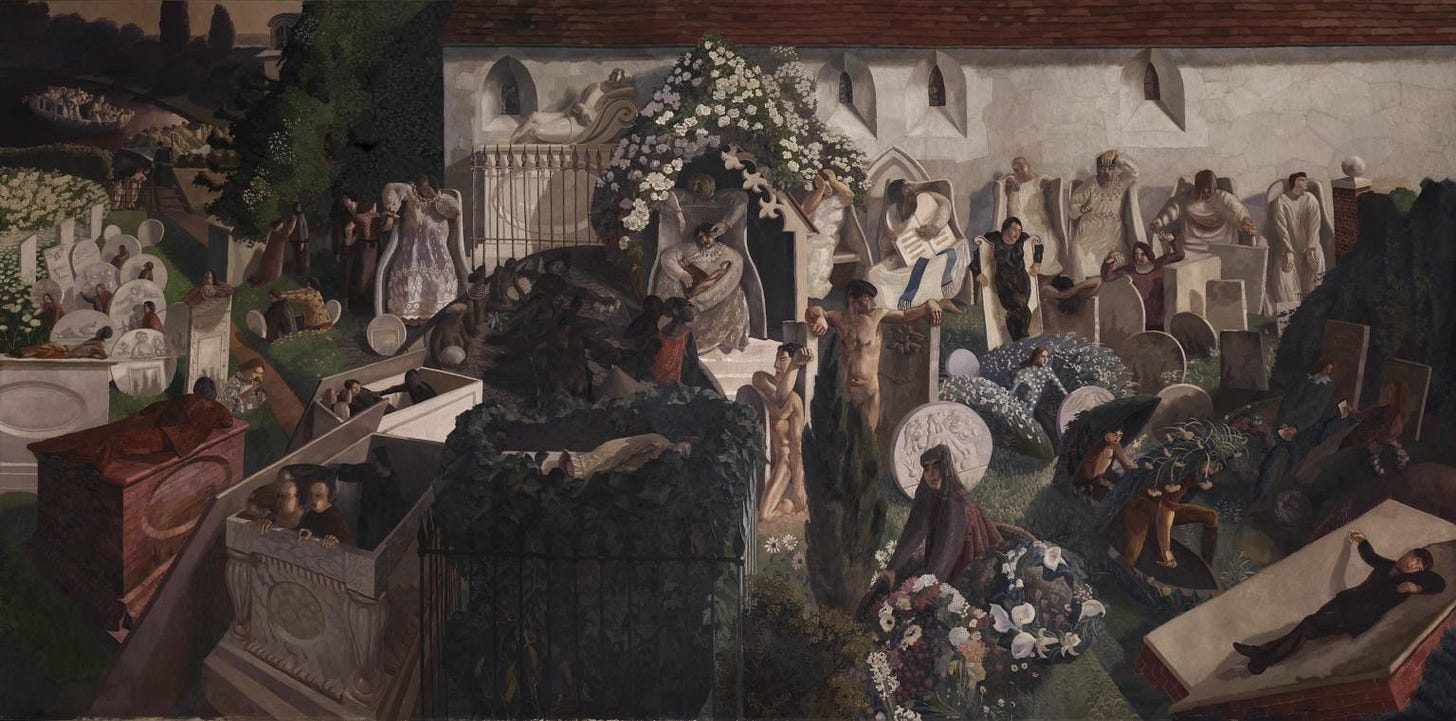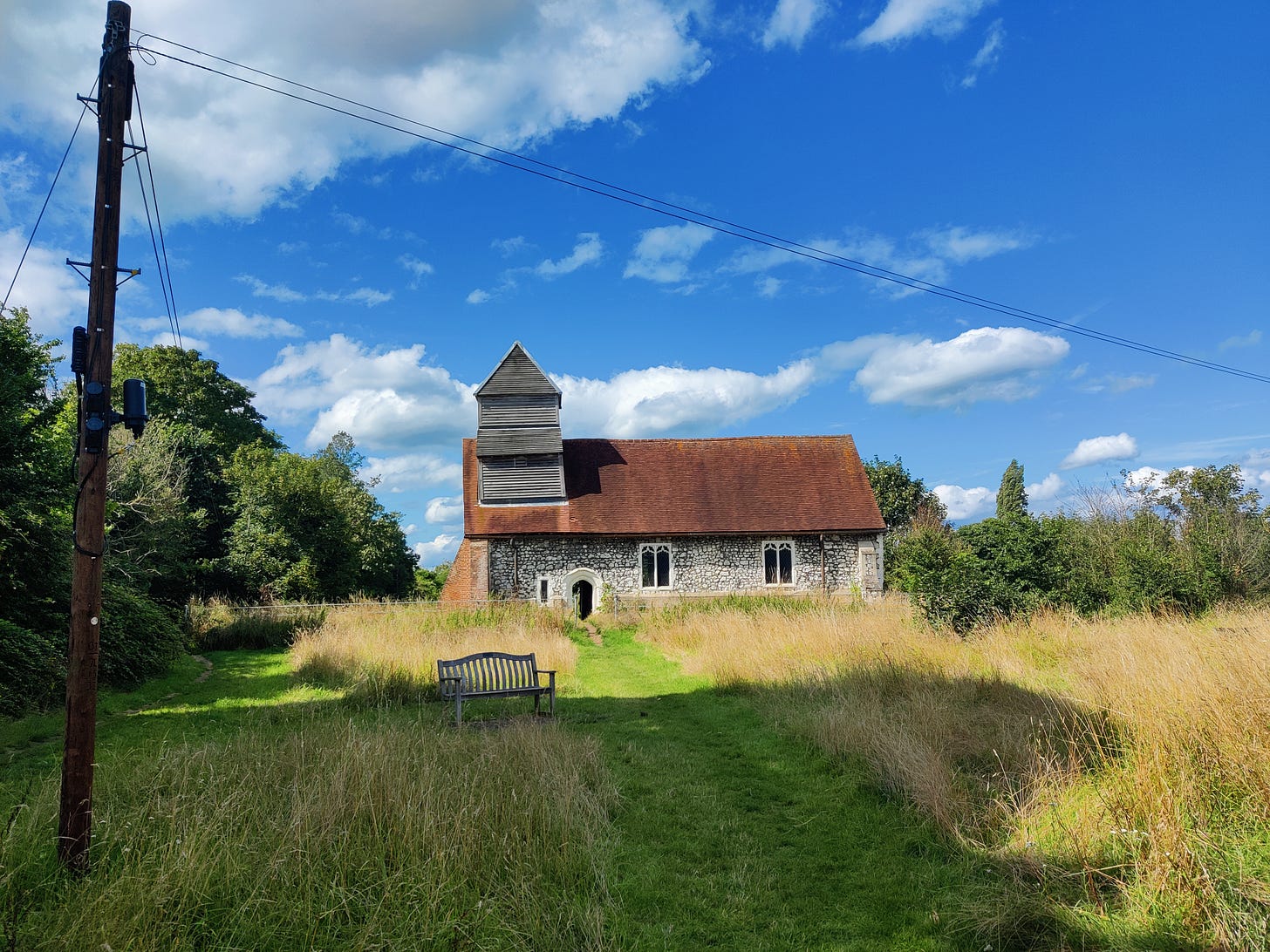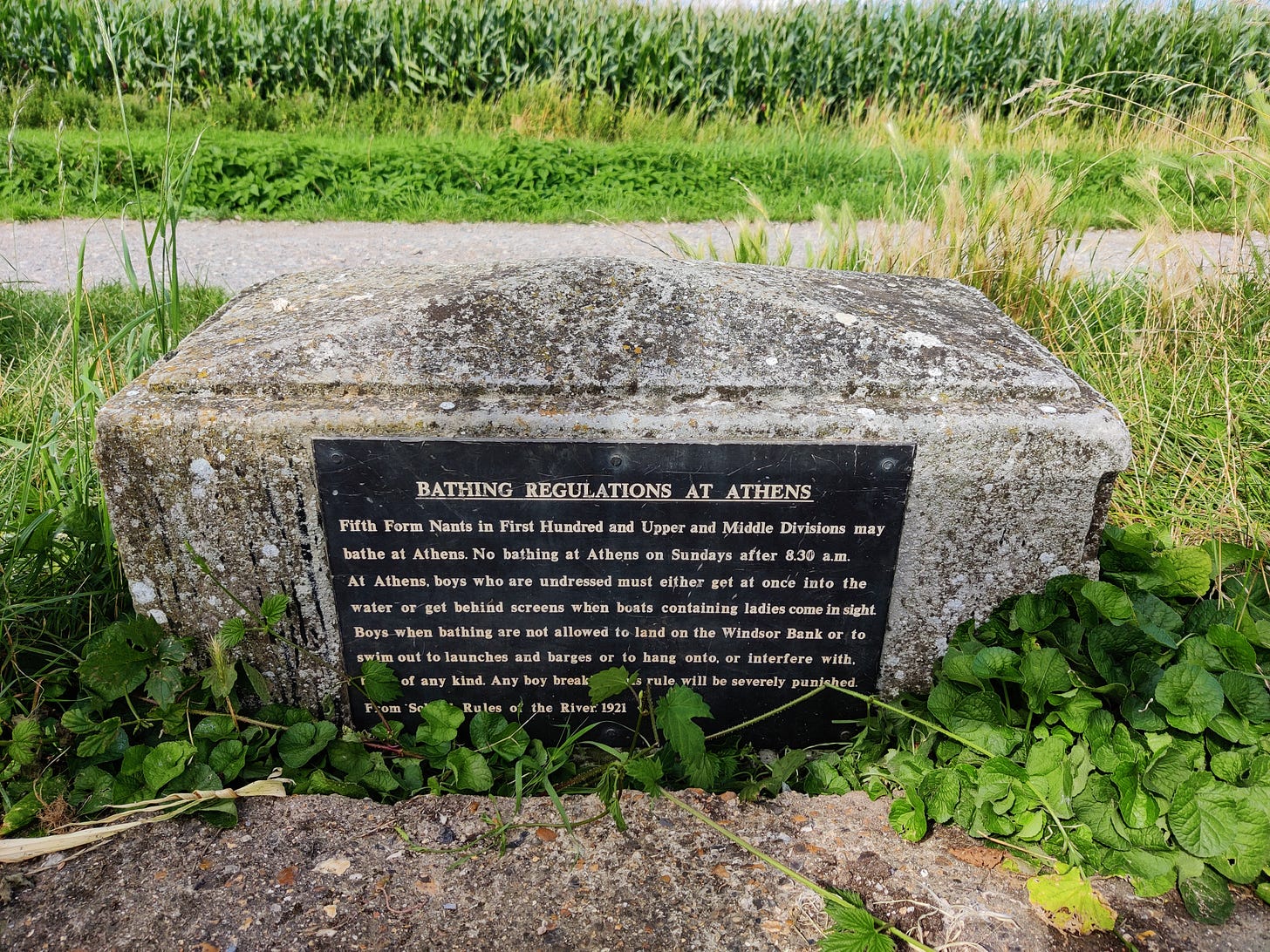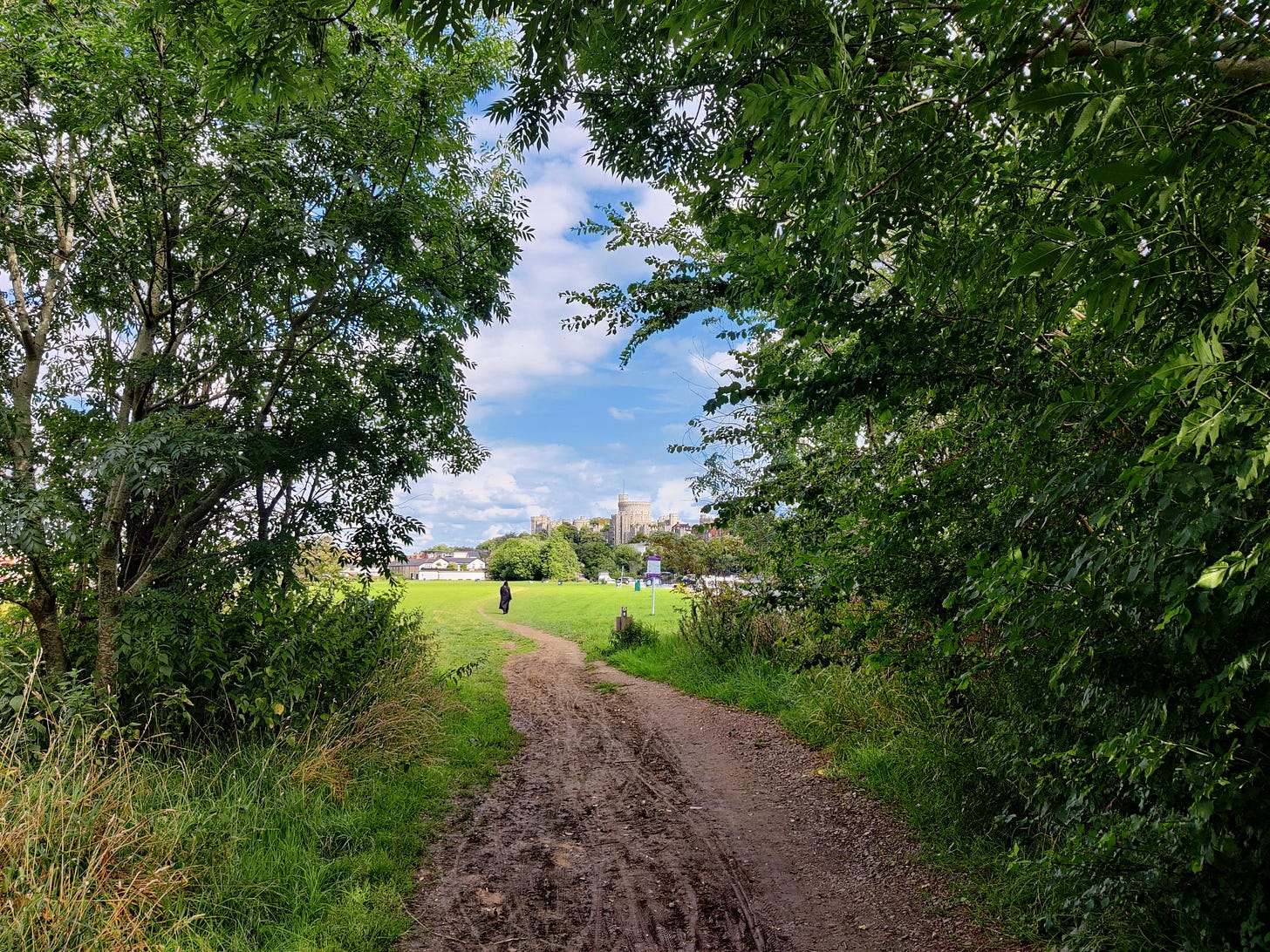Old Father Thames: Walking from Source to City... Chapter Nine
Trip Four, Day One: Marlow to Windsor
(Catch up on the previous chapter: Here! )
“When I lived in Cookham I was disturbed by a feeling of everything being meaningless. But quite suddenly I became aware that everything was full of special meaning and this made everything holy... I observed this sacred quality in most unexpected quarters.”
-STANLEY SPENCER, ARTIST
A month passed before we made any progress from Marlow. After a hot and stuffy night at the Sports Centre in Bisham, we decided to abandon the final planned day of our walk. Dad had been up most of the night, back and forth to the ensuite, with what ultimately turned out to be food poisoning, and, with temperatures set to get into the mid-thirties, he was in no state to walk the fourteen miles planned, which would have seen us complete the trip in the shadow of Windsor Castle. The extent of his queasiness was made very clear when he sent me down to the breakfast room alone while he stayed supine in the room, for my father NEVER refuses a hotel breakfast.
The ridiculous heat was all too evident as, at about 9am, we made our way out into the haze to repeat the previous night’s short walk into Marlow and to the station. We made slow progress but were able to stop off at All Saints Church, one of the few surviving parts of the Bisham Abbey estate, mostly now monopolised by the National Sports Centre where we’d spent the night. A priory was founded here by the Earl of Salisbury in the fourteenth century and it soon became a site of pilgrimage as well as the burial place for the Earls. It stood on the banks of the river for about two hundred years until its dissolution, as the final Abbot was dragged from the property he is said to have cursed the land, saying, “As God is my witness, this property shall ne’er be inherited by two direct successors, for its sons will be hounded by misfortune.” Nothing of the abbey remains but a Templar manor house, much expanded by the Salisburys, still stands at the heart of the complex. Now a conference centre, it was granted to Anne of Cleeves as part of her divorce settlement from the capricious Henry VIII. From her, it passed to the Hoby family, its longest residents. During the short and bloody reign of her Catholic sister, the future Elizabeth I was kept under effective house arrest here and would later frequently return to visit the Hobys as Queen. During this period Bisham was the domain of Lady Elizabeth Hoby, a formidable figure by all accounts, who, after four children with her first husband, remarried twice and had at least four more. However, the later the children, the more neglect they received. The story goes that, after getting frustrated with a young son who it seems might well have had learning difficulties, she beat him, tied him to a chair and locked him in an attic of the house before going out riding. Whilst riding she met a messenger and was summoned to Windsor to see the Queen, forgetting about the boy in the attic, who some days later was found dead, starved to death. The ghost of Lady Hoby has been seen walking the corridors of the house, crying for the loss of her child. She, along with most of the Hoby family, is buried in the church with elaborate tombs designed by Lady Hoby herself. The most impressive of which involves sculpted swans, an appropriate heraldic device for a Thameside family.
When we reach the church it is sadly locked, but, after talking to a lady in the churchyard, we discover we’re in luck, the church is about to be unlocked to provide tea for a travelling cycle tour who are expected to arrive any moment. We make the most of the cheerful arrival of parishioners with a tea urn and slip into the lavishly decorated structure to get a peek at the tombs before the peloton arrives. After this brief diversion, we continue into Marlow and straight to the station to make the long journey home before Dad gets much worse. Various rail closures meant it took all day, with a layover in Gloucester, to get back to Cardiff on the hottest day of the year and, in Dad’s case, with food poisoning. As such, we did not linger in Marlow, but it's not without interest as a riverside stop.
The main feature of note is the chain suspension bridge that crosses the Thames. Completed in 1832 by the engineer William Tierney Clark, it is the miniature-older-sister of the grand Széchenyi Chain Bridge that crosses the Danube at the heart of Budapest, also designed by Clark. Its towers, in the form of classical triumphal arches, mean the roadway is now rather too narrow for purpose, but the design itself is one of the most elegant of all the river bridges we’ve crossed.
So, fast-forward to August and we returned to Marlow to carry on the journey. What should have been the final day of our third trip, became the first day of our fourth, with Windsor still the destination for the night, and ultimately Richmond at the end of the three-day trip.
Leaving Marlow through the riverside meadows, we follow a wide and lugubrious river for a few miles into the small conurbation of Bourne End. The Marlow Branch Line slices between the river and the village centre, leaving a kind of hinterland made up of boat yards, rowing clubs, and chalets along the low, gently sloping bank. The place has the feeling of Famous-Five-style summer holidays, a post-war nostalgia, smelling of creosote, seems to pervade the dusty paths and faded bunting along the riverside. Crossing the river again, this time on a utilitarian box-girder railway bridge, we continue downstream, through more fields, to Cookham.
The path leaves the river and cuts through Cookham churchyard into the village centre. This is the platonic ideal of a Berkshire village; riverside, with an ancient church, pretty flint and brick cottages interspersed with the occasional grander Georgian home, a pub, hollyhocks, wisteria and roses climbing everywhere. It has been forever preserved in aspic by the paintings of Stanley Spencer. He was born here in 1891, in a house on the high street built by his grandfather where he would continue to live, even whilst studying in London and being an ambulance driver in Macedonia during the war, until his death in 1959.
Cookham became Spencer’s lifelong muse. A devout Christian, he began to see his local village and its inhabitants in biblical terms, producing painting after painting which transplanted Christian stories into the lanes of this sleepy Berkshire hamlet. The scene of the crucifixion becomes the villagers inspecting the hanging of a new scarecrow, St Francis preaching to the birds is recounted as a story of Spencer’s bearded father wandering the streets in his dressing gown whilst being pursued by geese. The curtains billowing out of an open sash window, as someone leans out, are transformed into angel wings, and children poking their heads between pointed iron railings are transformed into ranks of Roman soldiers with their spears.
His most ambitious and impressive work, The Resurrection, Cookham (1924-27), takes the church and graveyard as its theme. The inhabitants of the village, both modern and ancient, rise from their graves and walk down the church path (now part of the Thames Path) to the river, where they board boats to be taken to Paradise. Spencer himself appears in the vast work a number of times, as both a boy and a young man. More than thirty years later he was buried in the very same churchyard, and, as the Thames Path crosses the foot of his grave, we stop to pay our respects to one of my father’s favourite artists. On a visit to Cookham when a young boy, he remembers seeing an ageing Spencer pushing the battered black pram in which he kept his painting materials around the village. This strange object is now preserved in the village’s Stanley Spencer Gallery.
At this point we stopped for lunch at the satisfyingly alliterative Teapot Tea Shop. Dainty sandwiches with salad and crips taken in the garden, we carried on, out of Cookham, and back to the path.
We rejoined the river opposite Cliveden Woods. Cliveden (pronounced Clivdun) House, positioned on a ridge some forty metres above the river and entirely hidden from us behind the woods, had a chequered history. The current enormous Italianate palace was built in the mid-nineteenth century and is the third house to occupy the site which, over the centuries, has been home to a Prince of Wales, two Dukes, an Earl, and a Viscount. The last permanent residents were the Anglo-American Astors; Waldorf, a press-baron and real viscount, and his wife Nancy, the first woman to be elected a Member of Parliament. Under their ownership, during the 1920s and 30s, Cliveden played host to some of the liveliest political and cultural minds of the era, the infamous ‘Cliveden Set’, who would later be accused of having pro-Nazi sympathies, although there seems to be little evidence for this. A guest at one of these parties, Harold Nicholson, wrote: “There is a ghastly unreality about it all ... I enjoy seeing it. But to own it, to live here, would be like living on the stage of the Scala theatre in Milan.”
The weekend parties continued at Cliveden into the 1960s, when the estate became the centre of the Profumo Affair, after Secretary of State for War, John Profumo, was found to have lied to the Commons about an affair with nineteen-year-old model Christine Keeler. It was later revealed that Keeler had links with a Soviet agent and Profumo was forced to resign and shortly after the government suffered a major electoral defeat. The couple met for the first time, and frequently stayed, at Cliveden, often in Spring Cottage, visible across the water from the path.
Jerome K. Jerome thought that this stretch, between Cliveden and Maidenhead was “the sweetest… of all the river” and many others seem to agree from the appearance of the large and elaborate Thameside villas that signal the outer reaches of Maidenhead. Mostly Edwardian, they enjoy that brief window in English architectural history when the imagination was allowed to fly free and any fancy could be indulged. Conical towers, miniature domes, multi-level wooden verandas and Swiss-style gabled boat houses. Houses in every fashion from neoclassical to ‘Tudorbeathen’, their gardens spilling out verbena and lavender onto the towpath. These luxurious homes reach their climax at Boulters Lock. Now unremarkable when put side by side with any other river lock we’ve passed, at the turn of the last century this was the very heart of the ‘messing about in boats’ craze that captivated Londoners and made Jerome’s book such a success.
He did not, however, think much of Maidenhead itself, writing that it was “too snobby to be pleasant”, adding that “the heroine of the three-volume novel always dines there when she goes out on the spree with somebody else’s husband.” Fortunately, we see very little of Maidenhead on our journey, the centre of the town being quite a distance from the Thames, and we carry on to our final stretch to Windsor.
Before getting back into open country we must pass under Isambard Kingdom Brunel’s Maidenhead Railway Bridge. Built in 1838 to carry the Great Western Railway towards Bristol, it possesses the widest, flattest, brick arch in the world, which produces an exceptional echo as we walk beneath it. The bridge plays a starring role in one of the nation's favourite paintings, the steam train in JMW Turner’s Rain, Steam, and Speed charges across Maidenhead Railway Bridge with the silvery waters of the Thames glistening below. The painting forever memorialised it as one of the great symbols of modernity.
From Maidenhead to Windsor, about 7 miles, the path becomes quite monotonous. Skirting the edge of fields and gardens, under the M4 motorway, and around the perimeter of Eton College’s vast estate, including Dorney Water, their own man-made rowing lake. Bray, the village with the most Michelin-starred restaurants per capita of anywhere in the world, two in a village of under 10,000 people, is sadly on the opposite bank and only glimpsed through the trees. It was also home to the Hammer Horror film studios, famous for inventing the modern horror film in the middle of the last century.
Just before Windsor, we encounter two interesting fragments of riverside history. Firstly, the church of St Mary Magdalene, Boveney. This delightful tumble-down church appears like a mirage on the towpath, with no other building, or even a road, to be seen around it. The body dates to the twelfth century, with the distinctive wooden bell tower added in the fifteenth. It would seem that the church was built speculatively for a village that never got off the ground, hence its looking rather lost in the long grass by the riverbank, all alone. Subsequently, it became a ‘bargees’ church, a place of worship and rest of the many rivermen who came to and from a wharf nearby, shipping wood from the local forests. By the 1970s it was redundant and derelict but, thanks to the noble efforts of The Friends of Friendless Churches, and a donation from the nearby Eton College, it is now restored and open to the public, still with occasional services. It is a gorgeously tranquil and cool spot to rest while the sun beats down outside. The peace is only disturbed by the humming of insects in the reeds and grasses all around. Dad sits down at the inoffensively out-of-tune piano and plays a few bars of I Vow to Thee My Country whilst I read the humble brass plaque remembering a local man killed on the Western Front. All is peaceful in deep England.
A mile or so beyond this we reach Athens. Not the Greek capital of its namesake but a famous bathing spot reserved for use by boys from Eton in their free periods. A stone marks the place and declares the donation of the site to the college by the father of a boy killed in an aeroplane crash whilst a student. On the reverse is a rather humorous extract concerning bathing practices from the school’s rules of 1921 (see image). It doesn't look like much bathing goes on there these days, as it is fringed by brown sludge.
A few miles more and then all of a sudden, bursting through a tunnel in a thorn bush, there is Windsor Castle in all its stately grandeur, like a vision of Camelot on the hill. From this angle it is scarcely believable in its scale, one begins to realise why American tourists enter such raptures over it. Home to Kings and Queens for nearly a millennium, it curls around the contours of a hill which rises above the river like a sleeping dragon. The twin towns of Windsor and Eton bunch and huddle at its feet, from this distance at least, looking rather like towns from the background of medieval stained glass windows. As we cross the river for the final time that day, passing from Eton into Windsor, two violinists busking on the bridge play, appropriately, the Air from Handel’s Water Music.
We wend our weary way up the slopes of Windsor to our hotel in the backstreets of the town…
Next time: The long walk down The Long Walk…Magna Carta and the stolen crockery…Under the M25…and a race for the ferry…
(Thank you for reading! If you enjoyed, please consider subscribing to get all future instalments sent straight to your email inbox. You can also choose to support my writing (and walking) by choosing a paid subscription option.)


